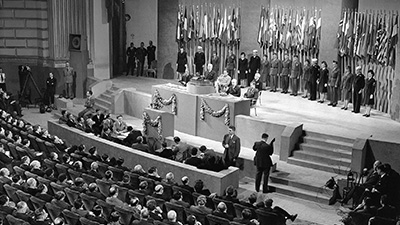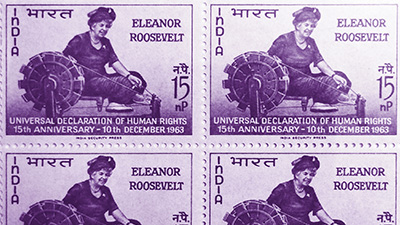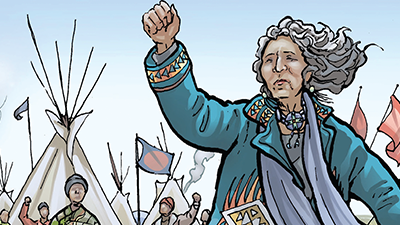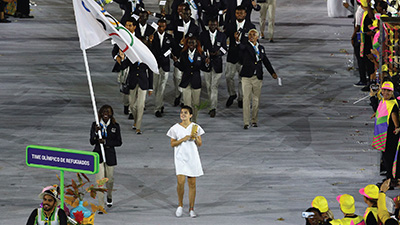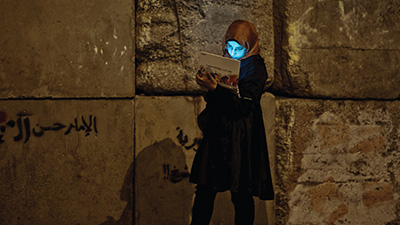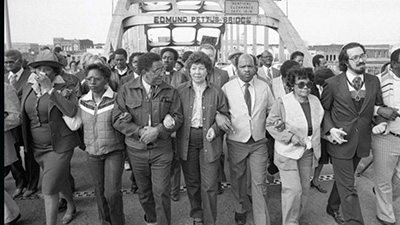Update ahead! This course will be updated soon. See what's changing.
Global Tensions
Driving Question: How do tensions between local and global trends affect people around the world?
During the twentieth century, several attempts were made to create international institutions that could help preserve peace and govern a rapidly changing world. The results of these efforts have been mixed. Yet, some new ideas entered the global consciousness as a result. In particular, the United Nations champions universal human rights, which it claims apply to all people, in all places, regardless of nationality or any other identity. As globalization ties us closer together, local communities have often resisted injustices. Recently, a resurgence of nationalism challenges the very notion of internationalism. Will our communities grow closer together or will injustice and conflict undermine cooperation?
- Analyze how human rights have been impacted in a modern world.
- Assess how globalization has affected communities in different ways around the world.
- Utilize the historical thinking skill of comparison to understand different rights documents.
-
Guiding Questions
-
Note: For more detailed directions on completing the three close reads below, refer to the Three Close Reads – Introduction activity.
Skim
Before you read, you should quickly skim the article, by looking at the headings of each section and the charts. Read the questions below as well, so you know what to look for when you read!
Key Ideas
- What is an “institution,” and why did leaders want to create them on a global scale after WWII?
- Why was the United Nations created, and what does it do?
- What were the two crucial economic institutions that formed after 1945, and what were their original goals?
- What is “economic liberalization,” and how did it differ from the original goals of global economic institutions?
- How do non-governmental institutions promote change on a global level?
- What are some of the positive and negative impacts global institutions have had on societies and human communities?
Evaluate
- The distinction between political, economic, and non-governmental institutions “isn’t always very neat.” What are some of the ways in which these institutions overlap?
- How have international institutions changed our world? Do you think these differences are the same everywhere, or do they vary across communities? Why might this be?
-
Guiding Questions
-
Note: For more detailed directions on completing the three close reads below, refer to the Three Close Reads – Introduction activity.
Skim
Before you read, you should quickly skim the article, by looking at the headings of each section and the charts. Read the questions below as well, so you know what to look for when you read!
Key Ideas
- What is the Universal Declaration of Human Rights, and why was it written?
- What were some ways that oppressed people used the Universal Declaration of Human Rights immediately after it was signed?
- What is the fundamental problem facing people who want to make human rights universal?
- What do cultural relativists argue?
- Are human rights an invention of Western imperialists?
- What are some ways that globalization has helped spread human rights? What are some ways that it has endangered human rights?
Evaluate
- Do you think that the concept of human rights is enough to protect people in the age of globalization?
Preserving the Past
Key Ideas
-
Guiding Questions
-
Before you watch
Before you watch the video, it’s a good idea to open and skim the video transcript. And always read the questions below so you know what to look and listen for as you watch!
While you watch
- According to Theresa Pasqual, why is it a mistake to refer to Pueblo historical sites and ancestral objects as “ruins” and “artifacts”?
- What challenges do Pueblo people face when trying to access places that are important to their history and culture today?
- Why does Brian Vallo say that “there’s no need to excavate” archaeological sites?
- What’s one problem that Dr. Swentzell mentions with returning human remains and cultural objects to the places from which they were removed?
- What are some examples of successful repatriation of remains and cultural items that Brian Vallo mentions?
After you watch
- How does this video make you think differently about some of the other archaeological and historical evidence you’ve learned about?
-
Guiding Questions
-
Note: For more detailed directions on completing the three close reads below, refer to the Three Close Reads for Graphic Bios – Introduction activity.
Observe
Skim the full comic, paying attention to things like prominent colors, shapes, and types of text and fonts. How do you know where to start and which direction to read? What’s in the gutters (the space between panels)? Who is the focus of the comic? What big questions do you have?
Understand
- Who was LaDonna Brave Bull Allard?
- Why did Sioux people oppose the Dakota Access Pipeline?
- What other battle was fought in this territory?
- What metaphor does LaDonna Brave Bull Allard, or Tamakawastewin, use to talk about the Dakota Access Pipeline?
- How did the artist use this metaphor and the connection between the battle of Whitestone Hill and the anti-DAPL protests to express the sentiments voiced by LaDonna Brave Bull Allard?
Connect
- Does the story of LaDonna Brave Bull Allard provide evidence that globalization is flat or lumpy? How?
-
Guiding Questions
-
Note: For more detailed directions on completing the three close reads below, refer to the Three Close Reads – Introduction activity.
Skim
Before you read, you should quickly skim the article, by looking at the headings of each section and the charts. Read the questions below as well, so you know what to look for when you read!
Key Ideas
- How does national belonging and the world of nation-states complicate international sports competitions? Consider examples like Taiwan and Kosovo.
- Why did international and transnational ideas surge in the second half of the twentieth century?
- How has nationalism helped with postwar reconciliation in Rwanda?
- In the age of the nation-state, how has racially defined nationalism reemerged?
- How do definitions of national identity exclude some people from cultural and political communities and resources?
Evaluate
- How do national identities shape your daily world, and the people and things you interact with?
- Are there transnational identities that shape the way you think about yourself and your daily interactions?
- What do you think the future of nationalism is? Will it continue to surge in the face of global challenges like climate change and pandemics, or will international and transnational solutions to these problems prevail?
Benazir Bhutto
Key Ideas
-
Guiding Questions
-
Before you watch
Before you watch the video, it’s a good idea to open and skim the video transcript. And always read the questions below so you know what to look and listen for as you watch!
While you watch
- Who was Benazir Bhutto’s father?
- What was the result of Benazir Bhutto’s first term in office?
- What did Bhutto focus on during her second term in office? Did she succeed?
- Why did Bhutto return to Pakistan and what was the result?
After you watch
- After watching this video, what is your assessment of Bhutto’s legacy? Was she an effective leader and proponent of women’s rights? Or was she ineffective and corrupt? What additional types of evidence would help you support your claim?
Time for the final comparison activity of the course. Read the excerpts and complete the Comparison Tool.
-
Guiding Questions
-
Note: For more detailed directions on completing the three close reads below, refer to the Three Close Reads – Introduction activity.
Skim
Before you read, you should quickly skim the article, by looking at the headings of each section and the images. Read the questions below as well, so you know what to look for when you read!
Key Ideas
- How have networks of knowledge changed since 1969?
- What are some ways that social media connects people?
- How has social media helped people to organize?
- What are some elements of the “dark side” of social media?
Evaluate
- In your personal experience, has social media and the internet made you feel more of a “global citizen” and connected to other people, more connected to your family and local community, or more isolated overall?
- How has the size and scale of networks changed over time? In a few sentences, describe the long history of changes in human networks.
-
Guiding Questions
-
Note: For more detailed directions on completing the three close reads below, refer to the Three Close Reads – Introduction activity.
Skim
Before you read, you should quickly skim the article, by looking at the headings of each section and the images. Read the questions below as well, so you know what to look for when you read!
Key Ideas
- How did the experiences of the Second World War contribute to the fight against racial discrimination and segregation in the United States?
- What was the impact of civil disobedience campaigns in the 1950s and 1960s in the United States?
- What were some elements of the US Civil Rights movement that made their way to Latin America?
- How were Black movements in Latin America connected to Indigenous rights movements?
- How does the author connect struggles for racial liberation with struggles for gender equality?
Evaluate
- How would you narrate the history in this article through the networks frame? What were the connections across regions and across groups in this article? How do you think these connections impacted struggles for equality in different regions?



